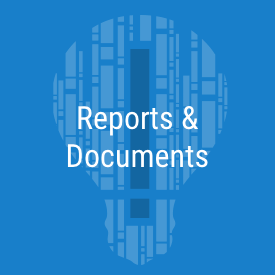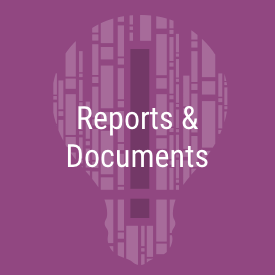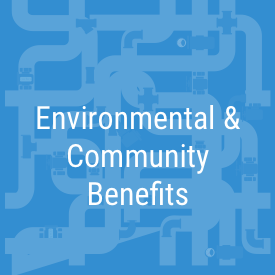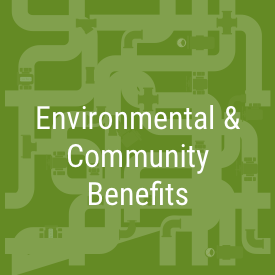This project reduces pollutants in streams, reservoirs and groundwater of Santa Clara County by supporting surface water quality pollution prevention activities. These programs address water quality concerns currently identified by local and state regulatory agencies, as well as contaminants of emerging concern. Initiatives under this project are consistent with the Regional Water Quality Control Board (RWQCB) impaired water bodies designation and Total Maximum Daily Loads (TMDLs), which are the maximum amount of a pollutant that a water body can receive and still safely meet water quality standards. Under this project, Valley Water studies and implements methods to reduce methylmercury formation in reservoirs, and helps create and carry out realistic plans to reduce contaminants, such as nutrients, bacteria, pesticides, polychlorinated biphenyls (PCBs) and others, in local creeks and reservoirs.
This project addresses both greenhouse gas (GHG) reduction and climate change adaptation, as reservoirs are a major source of GHG emissions (i.e. methane) during low oxygen conditions. Oxygenation is the current mechanism to control mercury in fish and may reduce methane emissions. Oxygenation can also reduce the formation of harmful algal blooms, which may become more frequent with warmer temperatures.








See Environmental & Community Benefits section for complete description of Key Performance Indicators (KPIs).
KPI #1: (Reduce methylmercury)
- The TMDL Monitoring Plan calls for monthly water quality sampling and spring and summer fish monitoring. Valley Water completed monthly water quality monitoring at Almaden, Calero, Guadalupe, and Stevens Creek reservoirs, and quarterly monitoring at Almaden Lake. Fish sampling was completed at Almaden, Calero, Guadalupe, and Stevens Creek reservoirs in Spring 2023. Another round of summer fish collection was completed in September 2023. The data will be included in the next biennial progress report in March 2024.
- Valley Water continued its collaboration with the University of California, Merced (UCM) to study the use of adsorbent materials for mercury remediation in reservoirs. The research team is currently designing preliminary bench experiments to evaluate and rank different adsorbent materials based on cost, effectiveness, and sustainability. Following this evaluation, priority adsorbents will be used to experimentally evaluate several application methods. In September 2023, Valley Water and UCM researchers collected water samples from Lexington Reservoir to extract dissolved organic carbon for use in their bench top experiments. Three sorbent materials have been tested; and a fourth is in the process of being acquired. Results will inform potential implementation actions in Guadalupe Reservoir.
- Valley Water coordinated with project partners and the RWQCB to implement the second 5-year phase of the Coordinated Monitoring Program for the Guadalupe River Watershed Mercury TMDL project. Valley Water partners with Santa Clara County, Midpeninsula Regional Open Space District, and Guadalupe Rubbish Disposal Company on the TMDL project. For more information on the TMDL project, please see the San Francisco Bay Regional Water Quality Control Board’s (Water Board) webpage here. Stream fish monitoring was delayed in 2021 and 2022 due to dry conditions or water temperatures exceeding permit thresholds. Monitoring resumed in June 2023 after January storms provided adequate flows and lower water temperatures. Two of the several large storms in January 2023 were sampled for mercury and methylmercury in water, according to the Monitoring Plan. The RWQCB approved a preliminary report and outline for the final Coordinated Monitoring Program Report. The final report was be submitted in January 2024.
- In December 2021, Valley Water entered into a collaborative agreement with the University of California, Santa Cruz (UC Santa Cruz) to study local atmospheric mercury deposition near the New Almaden Mining District using lichens as bioindicators. Field data collection was completed in 2022; sample analysis and reporting were completed in FY23. A second agreement was established to study the sources of atmospheric mercury accumulated in lichen. The second study began in March, 2023 and will continue through FY24.
- Valley Water deploys hypolimnetic oxygenation systems (HOSs) at some reservoirs to reduce the production of toxic methylmercury in the bottom waters. HOSs consist of a large oxygen generator that produces oxygen gas and distribution lines which bubble that oxygen into the bottom waters. This prevents the waters from being anoxic and reduces methylmercury production. However, HOS operation can also increase the temperature of reservoir releases and stimulate surface algae growth, particularly when storage volume is low. Valley Water operated an HOS at Calero Reservoir from May to October 2023. HOSs were not deployed at Guadalupe and Stevens Creek reservoirs to preserve cold water releases for fish downstream. Due to maintenance issues, an HOS was not also deployed at Almaden Reservoir.
KPI #2: (Prioritization plan)
- The Prioritization and Implementation of Pollution Prevention and Reduction Activities Plan to Address Impaired Water Bodies in Santa Clara County (Prioritization Plan) is periodically reviewed following the Water Board’s Triennial Review of the Basin Plan, which sets priorities for projects to address various impairment types. Valley Water uses the Water Board’s Triennial Review and its list of impaired water bodies to evaluate potential projects in water bodies within our jurisdiction. The Water Board completed the Triennial Review in November 2021, and Valley Water began updating the prioritization plan in summer 2022. Since Water Board priorities change over time as impairments are addressed and new problems are identified, the Prioritization Plan is a living document that is updated according to changing priorities.
- Valley Water is conducting a watershed assessment using available water quality, sediment chemistry, and habitat data. The analysis will help Valley Water identify potential water quality issues to be addressed under a revised B1 and B2 Project Prioritization Plan. An early draft of the 2023 Santa Clara County Watershed Assessment is undergoing internal review, and an updated Prioritization Plan is expected in mid-FY24.
KPI #3: (Surface water quality improvement activities)
-
Surface Water Quality Improvement Activity #1: Accumulation Point Mapping and Removal (Coyote Creek and Guadalupe River)
- Valley Water and the City of San José completed visual trash assessments along Coyote Creek and Guadalupe River in October and November 2023. Two accumulation points along Coyote Creek were prioritized for cleanup, and will be addressed when flow conditions allow. Valley Water and the City of San José will resume visual assessments to identify additional accumulation points in February 2024. The Coyote Creek and Guadalupe River Trash Accumulation Point Map from FY23 can be found in the Reports and Documents section of this webpage.
-
Surface Water Quality Improvement Activity #2: Reservoir Greenhouse Gas Emission Study
- Valley Water is conducting a collaborative project with the University of California, Davis to study greenhouse gas emissions from the surfaces of Almaden, Chesbro, Stevens Creek, and Uvas reservoirs.
- Since January 2021, researchers have completed sampling events to measure gas storage in reservoir sediments (measured quarterly) and greenhouse gas fluxes from reservoir surfaces in conjunction with atmospheric and water quality data (measured monthly). Data collection continued through November 2023 and results will be synthesized in a final report or manuscript. The primary goal of the study is to better estimate greenhouse gas emissions from all Valley Water reservoirs. Valley Water will evaluate the inclusion of reservoir-related emissions into its agency-wide greenhouse gas inventory after the completion of this study.
-
Surface Water Quality Improvement Activity #3 Unhoused Best Practices
- Valley Water continues to collaborate with Santa Clara County Parks and the cities of Morgan Hill and Gilroy to provide vouchers for responsible disposal of wastewater for unhoused individuals living in RV’s. Vouchers can be used for free RV waste disposal at Coyote Lake and Mt. Madonna County Parks. In FY23, waste disposal vouchers were distributed to unhoused individuals in Morgan Hill and Gilroy by homeless outreach providers, however none of the distributed vouchers were redeemed. To further incentivize the program, those who redeem the vouchers at one of the County Park disposal sites will also receive a gas gift card. Materials were provided to each County Park location in October 2023. The vouchers and gas gift cards will be available until June 30, 2024, at which point the activity’s effectiveness will be evaluated. No vouchers or gas gift cards were redeemed in Q2. Alternatives to the voucher program are under consideration.
January 2024
- Stevens Creek Reservoir Temperature, Turbidity, and Dissolved Oxygen Study 2020-2021
- Stevens Creek Reservoir Temperature, Turbidity, and Dissolved Oxygen Data Report 2020-2021
- Guadalupe River Watershed Mercury TMDL: 2020-2021 Progress Report on Methylmercury Control Measures in Reservoirs
Coordinated Monitoring Program
- CA Water Boards: TMDL
- Final Monitoring Plan
- Regional Board Approval Letter
- Guadalupe River Coordinated Monitoring Program 5-Year Report (2011-2016)
- Coordinated Monitoring Program Interim Monitoring Report 2018-2019
- Coordinated Monitoring Program 2019 Annual Progress Report
FY22-36 Key Performance Indicators for the Safe, Clean Water Program
-
Investigate, develop, and implement actions to reduce methylmercury in fish and other organisms in the Guadalupe River Watershed.
-
Prepare and update a plan for the prioritization of surface water quality improvement activities, such as addressing trash and other pollutants.
-
Implement at least two (2) priority surface water quality improvement activities identified in the plan per 5-year implementation period.
Benefits
-
Reduces contaminants in streams and reservoirs
-
Improves water quality, including water slated for drinking water treatment plants
-
Increases understanding of mercury cycling in reservoirs to develop strategies that reduce toxic methylmercury in fish consumed by people and wildlife
-
Increases the scientific understanding of environmental pollutants to assist in developing actions to manage them
-
Supports regulatory compliance with surface water quality standards for local creeks and reservoirs
-
Addresses climate change
Geographic Area of Benefit
Countywide
About the Safe, Clean Water and Natural Flood Protection Program
In November 2020, voters in Santa Clara County overwhelmingly approved Measure S, a renewal of Valley Water’s Safe, Clean Water and Natural Flood Protection Program.
The program was first passed by voters in 2000 as the Clean, Safe Creeks and Natural Flood Protection Plan, then again in 2012 as the Safe, Clean Water and Natural Flood Protection Program. The renewal of the Safe, Clean Water Program will continue to provide approximately $47 million annually for local projects that deliver safe, clean water, natural flood protection, and environmental stewardship to all the communities we serve in Santa Clara County.
While evaluating ways to improve the 2012 program, Valley Water gathered feedback from more than 21,000 community members. That helped Valley Water create the six priorities for the renewed Safe, Clean Water Program, which are:
- Priority A: Ensure a Safe, Reliable Water Supply
- Priority B: Reduce Toxins, Hazards and Contaminants in our Waterways
- Priority C: Protect our Water Supply and Dams from Earthquakes and Other Natural Disasters
- Priority D: Restore Wildlife Habitat and Provide Open Space
- Priority E: Provide Flood Protection to Homes, Businesses, Schools, Streets and Highways
- Priority F: Support Public Health and Public Safety for Our Community
Each year, Valley Water prepares a report providing a progress update for each of these program priorities, along with fiscal year accomplishments.
To ensure transparency and accountability to the voters, the ballot measure also created an Independent Monitoring Committee, appointed by the Santa Clara Valley Water District Board of Directors. The Independent Monitoring Committee annually reviews the program’s progress to ensure the outcomes are achieved in a cost-efficient manner and reports its findings to the Board. Additionally, the IMC also reviews each proposed 5-year implementation plan prior to its submittal for Board approval.
In addition, the program requires three independent audits.


